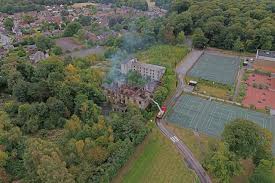Woolton Hall: The Untold Story of Liverpool’s Forgotten Masterpiece
“Woolton Hall”
Woolton Hall: The Untold Story of Liverpool’s Forgotten Masterpiece
When people think of Liverpool, they often picture The Beatles, Anfield Stadium, or the historic docks. Yet, hidden away in the Woolton area lies one of England’s most hauntingly beautiful treasures—Woolton Hall. This once-magnificent mansion, rich with history, art, and architecture, now stands as a shadow of its glorious past. But behind its crumbling walls lies a story that blends wealth, power, celebrity, and even whispers of the supernatural.
In this article, we’ll explore the fascinating history of Woolton Hall, its cultural significance, why it’s attracting global attention today, and what the future may hold for this architectural gem.

What is Woolton Hall?
Woolton Hall is an 18th-century Grade I listed country house located in the Woolton district of Liverpool, England. Built in 1704 for the Molyneux family, it was later redesigned in 1772 by the famous architect Robert Adam, one of Britain’s most celebrated neoclassical designers.
For centuries, Woolton Hall was a symbol of wealth, grandeur, and artistic excellence. Its elegant architecture, detailed interiors, and beautiful gardens made it one of the most distinguished country houses in the region.
The Golden Era of Woolton Hall
During the 18th and 19th centuries, Woolton Hall was home to some of the most influential families in Liverpool. Under Robert Adam’s redesign, the mansion became a showcase of neoclassical perfection. From sweeping staircases to intricately designed ceilings, it embodied the elegance of the aristocracy.
The house also reflected Liverpool’s growing power as a global trading hub. Many of its wealthy residents made fortunes from trade, industry, and politics. Woolton Hall wasn’t just a home—it was a statement of success.
The Decline of Woolton Hall
Sadly, the 20th century was less kind to this magnificent building. After years of changing ownership, Woolton Hall slowly slipped into decline. By the 1980s, it had ceased functioning as a residential property and was left abandoned.
Today, while the structure still stands, time and neglect have left their marks. Broken windows, peeling paint, and overgrown gardens tell a story of faded glory. Yet, even in decay, Woolton Hall continues to attract photographers, historians, and urban explorers from across the world.
Woolton Hall and The Beatles Connection
Liverpool is the birthplace of The Beatles, and almost every corner of the city has a link to the legendary band. Woolton Hall is no exception.
In 1957, John Lennon and Paul McCartney famously met for the first time at a church fete held at St. Peter’s Church, just a short distance from Woolton Hall. While the hall itself wasn’t the exact location of the meeting, its surrounding area played an important role in shaping the history of The Beatles. For many fans, Woolton Hall represents a piece of the cultural landscape that defined the band’s early years.
Ghosts of Woolton Hall – Fact or Fiction?
Like many historic mansions, Woolton Hall has earned a reputation for being haunted. Paranormal investigators claim to have seen shadowy figures in the grand halls, heard unexplained whispers, and even felt sudden drops in temperature.
One of the most popular ghost stories involves sightings of a lady in white, believed to be a former resident who never left. Whether you’re a believer or not, these tales add an extra layer of mystery to Woolton Hall and attract ghost hunters from around the globe.

Why Woolton Hall Still Matters Today
Despite its fragile condition, Woolton Hall remains one of Liverpool’s most important historic landmarks. It symbolizes not only the wealth and power of the city’s past but also the fragility of cultural heritage when preservation is ignored.
In recent years, campaigns have been launched to restore and preserve the mansion. Supporters argue that Woolton Hall could become a major tourist attraction, bringing jobs, investment, and cultural pride back to the area.
For heritage enthusiasts, the building is a reminder of how easily history can be lost if not protected.
Woolton Hall in the Age of Social Media
One of the reasons Woolton Hall has seen a resurgence in attention is due to social media. Photographers, urban explorers, and history lovers regularly share hauntingly beautiful images of the abandoned mansion online.
Platforms like Instagram, TikTok, and YouTube have given Woolton Hall a second life, transforming it into a viral sensation. What was once a forgotten relic is now a trending subject, attracting visitors from around the world.
Economic Potential – Why Investors Are Interested
Heritage sites like Woolton Hall are not just cultural treasures—they’re also potential high-value investments. With Liverpool’s growing tourism industry, restoring Woolton Hall into a luxury hotel, museum, or cultural center could yield significant returns.
Real estate investors, tourism companies, and even film producers have shown interest in properties like Woolton Hall. Imagine the economic boost if it were transformed into a wedding venue, filming location, or heritage tourism site.
This economic angle makes Woolton Hall a topic of interest not just for historians but also for entrepreneurs and policy-makers.
The Future of Woolton Hall – Can It Be Saved?
The biggest question remains: What will happen to Woolton Hall?
Without urgent restoration, the building risks further decay. However, with enough funding and public support, it could be transformed into a cultural landmark that benefits both the community and the economy.
Preserving Woolton Hall is about more than saving a building—it’s about protecting Liverpool’s identity, history, and global reputation.
Final Thoughts
Woolton Hall is more than an abandoned mansion—it’s a living reminder of Liverpool’s golden past, a canvas for its artistic heritage, and a stage for its mysterious legends. Whether you’re drawn to its architectural brilliance, its Beatles connection, or its ghostly tales, Woolton Hall captures the imagination like few other places.
As the world rediscovers this forgotten masterpiece, the future of Woolton Hall depends on how much value we place on history. If restored, it could once again shine as a jewel in Liverpool’s crown. If forgotten, it risks fading into dust.
For now, Woolton Hall stands as both a warning and an inspiration—proof that even in ruin, beauty endures.
